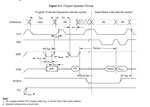rahdirs
Advanced Member level 1
Hi,
I'm trying to write a flash controller for writing,reading etc... into NOR flash S29GL01GP.
I have implemented the cycles that i need to follow for Program,Buffer Program,Erase etc.. as per the data sheet.Only thing left is to assert CE,OE,WE for the cycles based on the timing diagram given in the data sheet.
Example: To do buffer programming i have to follow the following cycles:

After writing an fsm which follows the above cycles,i need to following the timing diagram to drive CE,WE,OE etc....But i can't find the timing diagram for Buffer write programming.I can only fing timing diagram for Single Word Programming which is:

So how do i drive CE,WE,OE for the buffer programming ?
Datasheet: www.spansion.com/Support/Datasheets/S29GL-P_00.pdf
I'm trying to write a flash controller for writing,reading etc... into NOR flash S29GL01GP.
I have implemented the cycles that i need to follow for Program,Buffer Program,Erase etc.. as per the data sheet.Only thing left is to assert CE,OE,WE for the cycles based on the timing diagram given in the data sheet.
Example: To do buffer programming i have to follow the following cycles:

After writing an fsm which follows the above cycles,i need to following the timing diagram to drive CE,WE,OE etc....But i can't find the timing diagram for Buffer write programming.I can only fing timing diagram for Single Word Programming which is:

So how do i drive CE,WE,OE for the buffer programming ?
Datasheet: www.spansion.com/Support/Datasheets/S29GL-P_00.pdf

